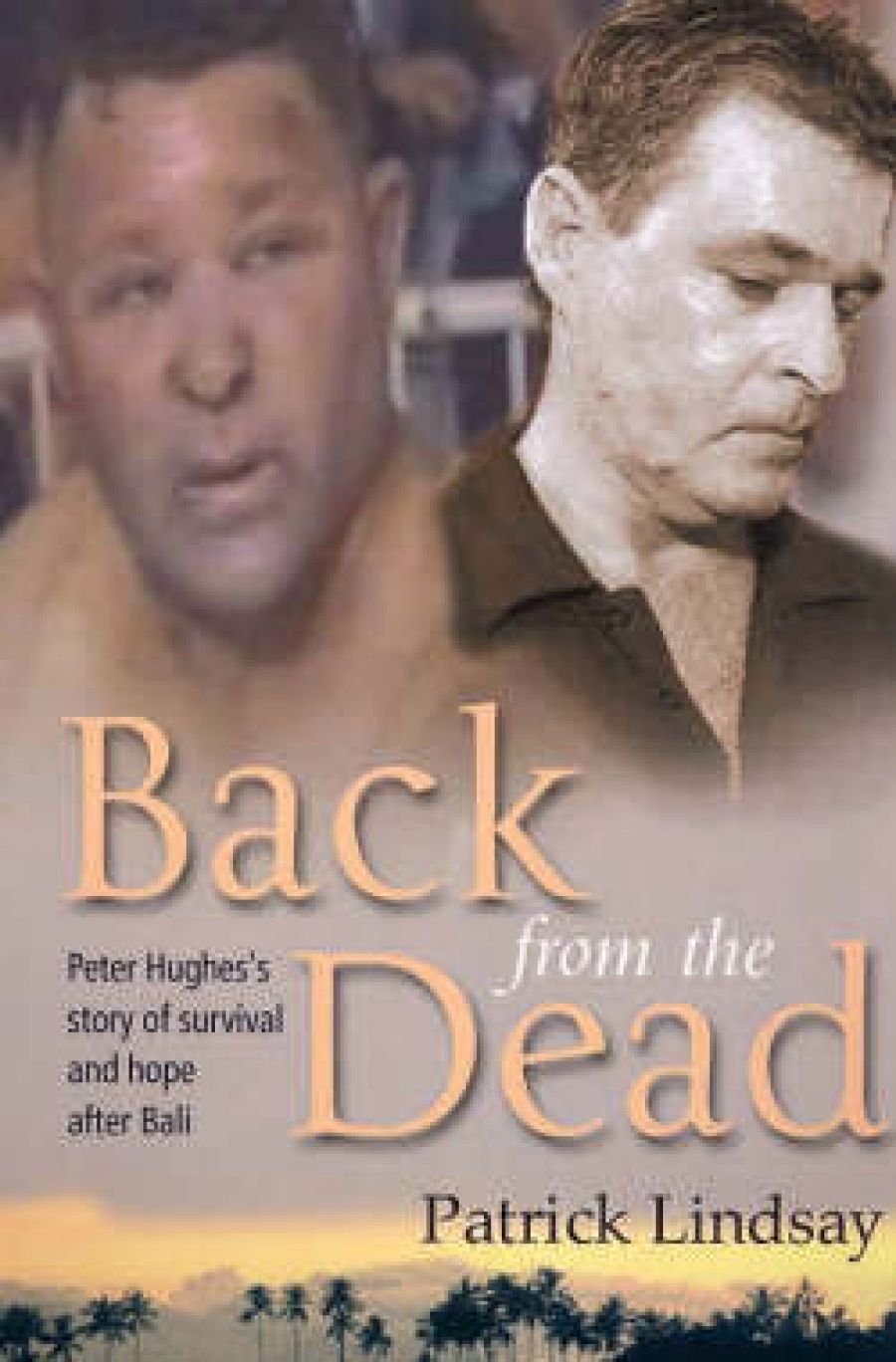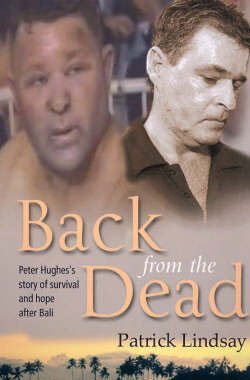
- Free Article: No
- Custom Article Title: Kuta Madness
- Review Article: Yes
- Article Title: Kuta Madness
- Online Only: No
- Custom Highlight Text:
Patrick Lindsay’s Back from the Dead, one of the first books published on the Bali bombing, is primarily an evocation of the inferno and its aftermath, through the eyes of those who survived it. There is ‘Peter’s story’ (the author’s central focus), ‘Nashie’s story’, ‘Col’s story’ and so on, all interpolated with extensive quotes, mostly from the victims of the blast. Despite the painfully vernacular tone of the early chapters, this book is a good primer on the terrorist attack and its consequences.
- Book 1 Title: Back from the Dead
- Book 1 Subtitle: Peter Hughes’ story of survival and hope after Bali
- Book 1 Biblio: Random House, $29.95 pb, 259 pp
- Book 1 Cover Small (400 x 600):

- Book 1 Cover (800 x 1200):

Lindsay’s narrative begins a few weeks before the blast, with a glimpse of the carefree life of Peter Hughes and his friends in Perth. It’s a matey, horsy, footy-loving, beer-swilling fraternity, whose innocent world is contrasted with a parallel narrative of the terrorists as they prepare their arsenal in Java. An imprecise synchronicity between the activities of the two groups undermines its dramatic potential. Still, it allows Lindsay to introduce the terrorist theme to the reader and to establish the pattern of linked narratives that he employs so effectively throughout this book.
The bombing itself is told vividly from multiple view-points, with each victim adding something new to the collage of horror. These eyewitness accounts, immediate and authentic, are sometimes shocking, but never gratuitous.
When Hughes, the human face of the Bali bombing, asked a local for water soon after the blasts, he was told, ‘No, you can burn, fucking burn, Aussies.’ Might he have stumbled on a terrorist? Perhaps, but as he walked down an alley there were several ‘altercations’ with local people who, he felt, refused to help him and indeed tried to impede him. Peter thought ‘they were there for a reason’.
Feeling no pain and blissfully unaware of the seriousness of his injuries, Hughes gave a seemingly spirited interview soon after the blast. This image is seized on by the media as an example of a stoical, uncomplaining, defiant Australian spirit. Peter Overton, from 60 Minutes, puts an early programme to air. In the foreword to Back from the Dead, Overton defines heroism: ‘Too often,’ he warns, ‘we use words like “hero” and “legend” in everyday conversation, but I have come to realise that these words should be reserved for people like Peter and every person who survived or perished in Bali.’ With almost comical earnestness, Overton elevates the commonplace, while demeaning the truly heroic. Thus 60 Minutes transformed largely fictional individual heroics into collective qualities. Even eminent political commentator Paul Kelly went on to compare the victims of Bali to the Anzacs: ‘[T]hey wore no uniforms … the Anzac spirit lives in their voices, and in their pain, in their grief for others and in their guilt about surviving. It showed in their fortitude, courage and loyalty.’ These institutional outpourings of national feeling are surely one of the most interesting aspects of the Bali bombing.
Although Lindsay extols his subjects, he tries, not always successfully, to avoid Kelly’s sugary tone, but these tough men do lapse, in their grief, into what Russel Ward has called ‘sentimental bathos’.
Back from the Dead, whose early chapters are burdened by a sloppy vernacular tone, has some features of a post-Bali quickie. But then it surprises with its astute meshing of narratives and added substance. One is impressed by the number of people the author has interviewed, and by the intriguing information they provide. Lindsay quotes, for example, Fiona Wood, Director of the Royal Perth Hospital Burns Unit, who introduces us to the surgical procedures, complications and suffering of those who were severely burnt. There is an excellent chapter devoted to the problems facing Mick Keelty, Commissioner of the Australian Federal Police. Lindsay also quotes Dr Chris Griffiths, a dental forensic expert, who is given the daunting task of identifying those killed in the blast. Surprisingly, half of those family members who claim to have visually identified victims are proved wrong.
Lindsay’s book mirrors the soothing paradigms of heroism, resilience, mateship and humanity. He depicts Hughes as a typical Aussie battler. Yet Lindsay seems mildly ambivalent about the culture he describes. The nomenclature of his early chapters, with its ‘raging’, ‘pumping’, its ‘blowouts’, suggests a vulgar hedonism so conspicuous in Bali’s Kuta district each October. It is Lindsay, after all, who informs us ‘that the local Balinese wince around this time of year’, as the ‘end of season party-goers’ arrive at Bali. One wonders if they ‘wince’ at other times of the year.
Thus, to some extent, Lindsay qualifies his reader’s sympathy for the victims. By making it more complicated, Lindsay’s subtle ambivalence enhances the book, rather than spoiling it. By contrast, the reader will feel deeply and unambiguously moved by those who cared for the burnt victims: volunteers such as the angelic Chrissie Lincoln, the nurses in intensive care wards, and doctors such as Dr John Greenwood of the Adelaide Hospital Burns Unit.
Lindsay’s book will remind some readers of the power of national sentiment to transpose hedonistic excess into the carefree plank of our national identity. If the Bali bombing made us feel vulnerable to terrorist attack, it also showed how vulnerable we are to the sometimes distorting forces of political rhetoric and the media.
One wonders, too, whether the ‘Kuta madness’, as Lindsay puts it, accounts in part for the predominantly negative impressions that Indonesians have of Australians. Is Kuta just one of those contentious sites that promotes a less than representative, socially unedifying image of Australians across South-East Asia?
Back from the Dead will prompt readers in unexpected ways. It will certainly repay the reading.


Comments powered by CComment